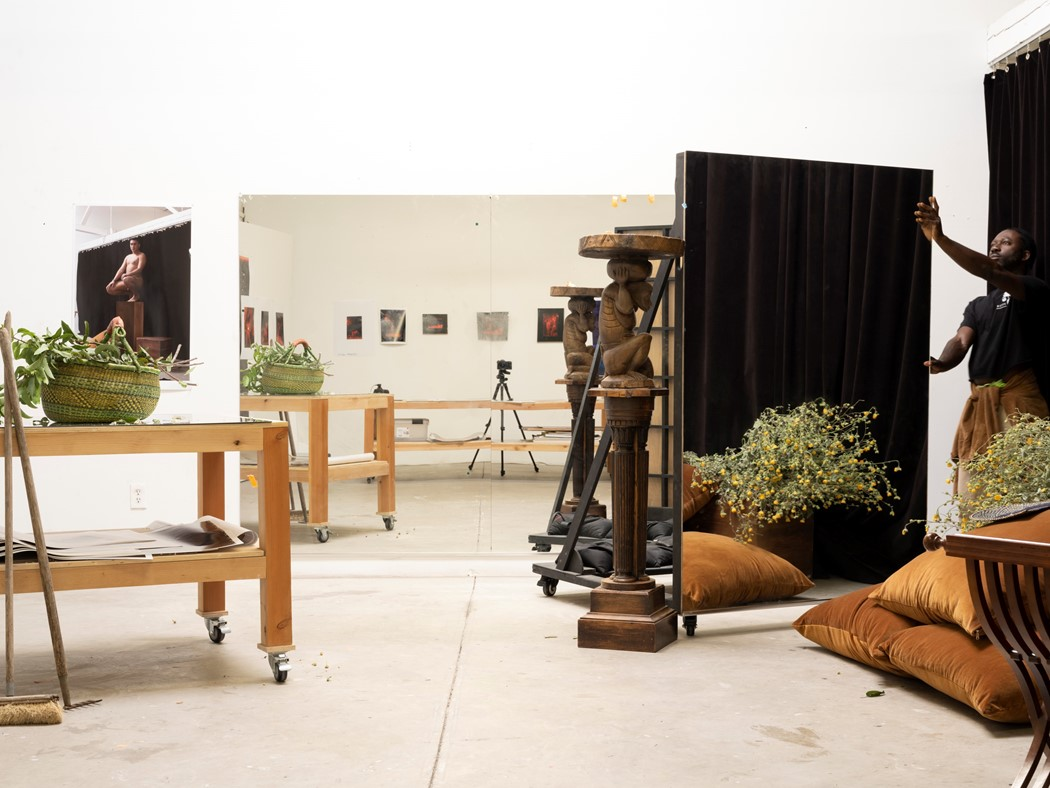Paul Mpagi Sepuya
Drop Scene (0X5A9306), 2021.
Paul Mpagi Sepuya, an American artist born in 1982, resides and creates in LA, where his photography delves into themes of love, intimacy, and vulnerability. His editorial work has graced the pages of I.D., Kaiserin Magazine, and BUTT Magazine. Despite years of dedication, Sepuya initially lacked significant institutional recognition. However, in 2018, he earned a spot in MoMA’s prestigious New Photography 2018, highlighting artists at the photography forefront. Subsequently, his presence was felt at the 2019 Whitney Biennial, launching his worldwide recognition.
Darkroom Mirror (0X5A0752), 2019.
Sepuya defies simple categorization as merely a photographer; he identifies as an artist, grappling with the complexities of his craft. His creations are not commodities for hire or mere aesthetics; instead, they embody depth and intellect. Sepuya once expressed his discomfort with the label “photographer,” emphasizing his role as an artist crafting pieces meant for gallery walls with meticulous consideration.
Darkroom (1990407), 2016.
For two decades, Sepuya has been defying the conventions of portraiture, opting for compositions where subjects are not centrally positioned but rather fragmented within larger narratives. While his approach blurs the line between traditional portraiture and self-portraiture, Sepuya maintains the centrality of the camera in capturing the dynamic relationships between artist, subject, viewer, and artwork. His subjects, drawn from his personal circle, contribute to a natural narrative enriched by longstanding relationships, eschewing casting in favor of genuine connections. He explained: ‘There are friends, and there are some friends that I’ve photographed for 15 or 20 years at this point. There are some friends too, I’ve known for a long time but have only recently started to photograph. Maybe there’s some people that I’m just getting to know, but I don’t photograph strangers or models.’ Sepuya further disrupts portraiture conventions through the strategic incorporation of mirrors, leveraging their reflective surfaces within his studio to capture unique perspectives. Additionally, he employs collages with meticulous placement and arrangement, serving as narrative devices that complement his exploration of fragmented bodies and enrich the storytelling aspect of his work.
Figure With Poppies After RBN (2604), 2015.
Dazed aptly described Sepuya’s photography as “cerebral yet erotic,” capturing the essence of his work. While an undeniable eroticism permeates his photographs, occasionally invoking a voyeuristic allure from the viewer’s perspective, they transcend mere sensuality. Sepuya’s images evoke a profound sense of longing, vulnerability, desire, and intimacy, imbued with a playful warmth that invites contemplation and connection. Sepuya’s work delves into complex themes such as queer bodies, sexuality, race, and colonial history, aiming to fill the void in traditional photography discourse regarding the representation of Black queer individuals. He elucidates his mission, stating, “I’m interested in how visualized racial difference works in pictures and how representations of queer and homoerotic acts engage with the fundamental and underlying formal, technical, and historical processes of photography.” Moreover, Sepuya seeks to explore how the portrayal of diverse races manifests in images, striving for a comprehensive representation of queer communities. In an interview with Wallpaper magazine, he expressed his desire to catalyze discussions on the formation of queer spaces, queer relationships, mutual envisioning, and objectification, all interconnected with the intrinsic desire for visual representation inherent in photography.
Daylight Studio (DSCF0043), 2021.
In recent years, Sepuya has introduced various objects into his studio, many of which serve as references to the colonial legacy inherent in portraiture. These objects include a Roman Savonarola armchair, a Persian rug, a Ghanaian Bolga fan, sienna-colored cushions, and antique plinths. Typically, he positions his subjects alongside these objects against a black background, a deliberate choice that highlights the background’s imperfections, such as smudges and smears. This departure from the pristine cleanliness often associated with commercial photography imbues his work with a sense of humanity and tactile reality. Sepuya’s art defies categorization; he systematically deconstructs artistic conventions to craft his distinctive narrative, challenging traditional norms and offering a fresh perspective on the medium.
I highly recommend checking out two insightful interviews conducted by AnOther and Dazed magazine, where you can delve deeper into Sepuya’s artistic process and gain a further understanding of his work. These interviews provide valuable perspectives and offer a rich exploration of the artist’s motivations, inspirations, and creative process.
Dark Room Model Study (0X5A1728), 2021.
The recent exhibition, “Exposure,” represents a significant milestone in Sepuya’s career, marking his first institutional showcase in the UK at Nottingham Contemporary, which opened on January 27th. Featuring over 40 works, including three new sculptural pieces, the exhibition delves into the theme of ‘exposure,’ offering a nuanced exploration of its dual meanings. Sepuya’s art delves into the intricate interplay between the camera, subject, and viewer, utilizing mirrors both symbolically and practically. Mirrors are employed to both hold and layer image fragments while deflecting direct viewer gaze, underscoring themes of visibility and invisibility. Through his documentation of subjects and photographic processes, Sepuya probes the nuances of queer intimacy, pondering the visible and invisible aspects left in the wake of subjects vacating the studio. This framing of ‘exposure’ not only contextualizes Sepuya’s work but also invites viewers to contemplate the multifaceted nature of visibility, vulnerability, and revelation inherent in the artistic process.
Dark Room Studio Mirror (0X5A3797), 2022.







